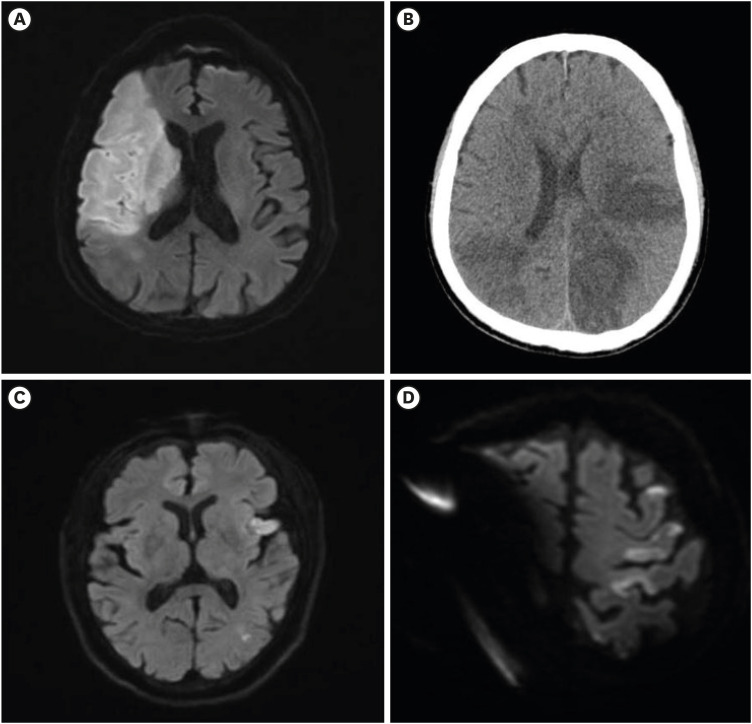J Korean Med Sci.
2020 Sep;35(35):e324. 10.3346/jkms.2020.35.e324.
Characteristics of Acute Stroke in Patients with Coronavirus Disease 2019 and Challenges in Stroke Management during an Epidemic
- Affiliations
-
- 1Department of Neurology, Keimyung University Daegu Dongsan Hospital, Keimyung University School of Medicine, Daegu, Korea
- 2Department of Neurology, Daegu Catholic University Hospital, Catholic University of Daegu School of Medicine, Daegu, Korea
- 3Department of Neurology, Kyungpook National University Chilgok Hospital, School of Medicine, Kyungpook National University, Daegu, Korea
- 4Department of Neurology, Yeungnam University Hospital, Yeungnam University School of Medicine, Daegu, Korea
- 5Department of Neurology, Keimyung University Dongsan Hostpial, Keimyung University School of Medicine, Daegu, Korea
- KMID: 2506090
- DOI: http://doi.org/10.3346/jkms.2020.35.e324
Abstract
- Coronavirus disease 2019 (COVID-19) is an ongoing pandemic infection associated with high morbidity and mortality. The Korean city of Daegu endured the first large COVID-19 outbreak outside of China. Since the report of the first confirmed case in Daegu on February 18, 2020, a total of 6,880 patients have been reported until May 29, 2020. We experienced five patients with ischemic stroke and COVID-19 during this period in four tertiary hospitals in Daegu. The D-dimer levels were high in all three patients in whom D-dimer blood testing was performed. Multiple embolic infarctions were observed in three patients and suspected in one. The mean time from stroke symptom onset to emergency room arrival was 22 hours. As a result, acute treatment for ischemic stroke was delayed. The present case series report raises the possibility that the coronavirus responsible for COVID-19 causes or worsens stroke, perhaps by inducing inflammation. The control of COVID-19 is very important; however, early and proper management of stroke should not be neglected during the epidemic.
Keyword
Figure
Reference
-
1. Jin H, Hong C, Chen S, Zhou Y, Wang Y, Mao L, et al. Consensus for prevention and management of coronavirus disease 2019 (COVID-19) for neurologists. Stroke Vasc Neurol. 2020; 5(2):146–151. PMID: 32385132.
Article2. Kim ES, Chin BS, Kang CK, Kim NJ, Kang YM, Choi JP, et al. Clinical course and outcomes of patients with severe acute respiratory syndrome coronavirus 2 infection: a preliminary report of the first 28 patients from the Korean cohort study on COVID-19. J Korean Med Sci. 2020; 35(13):e142. PMID: 32242348.
Article3. Beyrouti R, Adams ME, Benjamin L, Cohen H, Farmer SF, Goh YY, et al. Characteristics of ischaemic stroke associated with COVID-19. J Neurol Neurosurg Psychiatry. 2020; 91(8):889–891. PMID: 32354768.
Article4. Oxley TJ, Mocco J, Majidi S, Kellner CP, Shoirah H, Singh IP, et al. Large-vessel stroke as a presenting feature of Covid-19 in the young. N Engl J Med. 2020; 382(20):e60. PMID: 32343504.
Article5. Ministry of the Interior and Safety. Coronavirus Disease-19, Republic of Korea. Updated 2020. Accessed March 3, 2020. http://ncov.mohw.go.kr/en.6. Sung HK, Kim JY, Heo J, Seo H, Jang YS, Kim H, et al. Clinical course and outcomes of 3,060 patients with coronavirus disease 2019 in Korea, January–May 2020. J Korean Med Sci. 2020; 35(30):e280. PMID: 32743995.
Article7. Baig AM, Khaleeq A, Ali U, Syeda H. Evidence of the COVID-19 virus targeting the CNS: tissue distribution, host-virus interaction, and proposed neurotropic mechanisms. ACS Chem Neurosci. 2020; 11(7):995–998. PMID: 32167747.
Article8. Hess DC, Eldahshan W, Rutkowski E. COVID-19-related stroke. Transl Stroke Res. 2020; 11(3):322–325. PMID: 32378030.
Article9. Tang N, Bai H, Chen X, Gong J, Li D, Sun Z. Anticoagulant treatment is associated with decreased mortality in severe coronavirus disease 2019 patients with coagulopathy. J Thromb Haemost. 2020; 18(5):1094–1099. PMID: 32220112.
Article10. Bikdeli B, Madhavan MV, Jimenez D, Chuich T, Dreyfus I, Driggin E, et al. COVID-19 and thrombotic or thromboembolic disease: implications for prevention, antithrombotic therapy, and follow-up: JACC State-of-the-Art Review. J Am Coll Cardiol. 2020; 75(23):2950–2973. PMID: 32311448.11. Zu ZY, Jiang MD, Xu PP, Chen W, Ni QQ, Lu GM, et al. Coronavirus disease 2019 (COVID-19): a perspective from China. Radiology. 2020; 296(2):E15–25. PMID: 32083985.
Article12. Kim JY, Kang K, Kang J, Koo J, Kim DH, Kim BJ, et al. Executive summary of stroke statistics in Korea 2018: a report from the Epidemiology Research Council of the Korean Stroke Society. J Stroke. 2019; 21(1):42–59. PMID: 30558400.
- Full Text Links
- Actions
-
Cited
- CITED
-
- Close
- Share
- Similar articles
-
- Coronavirus Disease 2019 and Stroke
- Stroke in a Young Age COVID-19 Patient: Vasculitis Feature and Changes in Cerebral Vessel Stenosis
- Pathomechanism and Management of Stroke in COVID-19: Review of Immunopathogenesis, Coagulopathy, Endothelial Dysfunction, and Downregulation of ACE2
- Organization of Stroke Care System: Stroke Unit and Stroke Center
- General Management of Acute Stroke


